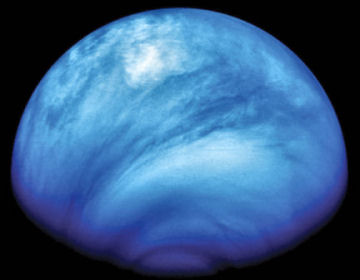Venus unveiled
A recent mission to Venus has revealed new information about that planet's watery past.
By Emily Sohn
The search for water on other planets has focused mainly on Mars. But there is water on Venus, too. And Venus used to have even more of the liquid than it does now, according to a recent mission to the planet.
Venus is the closest planet to Earth, and the planets share much in common. So, scientists have long been curious to learn more about Venus. That’s been hard to do, however, because dense clouds of sulfuric acid blanket our nearest neighbor.
 |
|
The Venus Express probe recently dove through the clouds on our nearest planetary neighbor. This image shows the planet’s southern hemisphere.
|
| European Space Agency |
To get a closer look, the European Space Agency launched the Venus Express probe in 2005. The probe dove through Venus’ clouds and sent back all sorts of new information about the planet.
Among the findings, the mission proved that Venus has lightning. And it revealed that the planet’s temperature varies much more than scientists expected. From night to day, temperature rises 40°C (104°F).
The probe also found a hot spot near Venus’ south pole. The spot is 10°C (50°F) warmer than the atmosphere near it. Scientists had previously discovered a similar hot spot near the planet’s north pole.
One of the biggest questions scientists had before the mission involved the history of water on the planet.
“There’s some water, but where’s the ocean on Venus?” asks Andy Ingersoll of the California Institute of Technology in Pasadena. “Venus Express has addressed that.”
Water is made up of hydrogen and oxygen. If Venus used to have more water than it does now, scientists reasoned that large amounts of hydrogen and oxygen would have escaped the planet’s gravity in the past.
However, there is a type of hydrogen called deuterium that is heavier than typical hydrogen. Because of its weight, deuterium can’t escape gravity as easily as lighter hydrogen can. So, if large amounts of water had disappeared from Venus over the years, there should be a larger ratio of deuterium to regular water left behind.
In fact, that’s exactly what a team of French researchers found. Their calculations showed that there would have once been enough water to cover the planet with at least 4.5 meters (15 feet) of water. Today, there is only enough water vapor in Venus’ atmosphere to cover the planet with 3 centimeters (1.2 inches) of water, if the vapor were an ocean.
(Earth has far more water than Venus ever did. If all the water on our planet were spread around the globe, it would be 2.8 kilometers (1.7 miles) deep).
Understanding the history of water on Venus can help us understand the future of water on Earth, scientists say. When a climate heats up, oceans evaporate. Extra water vapor in the atmosphere traps more heat, causing the oceans to heat up and evaporate even more quickly.
“If this runaway greenhouse effect could happen on Venus,” Ingersoll asks, “could it happen on Earth too?”
Going Deeper:
Williams, Sarah. 2007. Sister planet: Mission to Venus reveals watery past. Science News 172(Dec. 1):339. Available at http://www.sciencenews.org/articles/20071201/fob1.asp .







